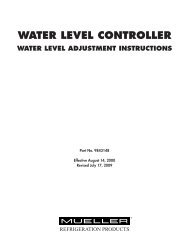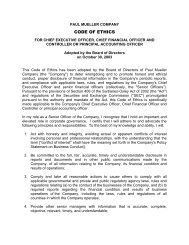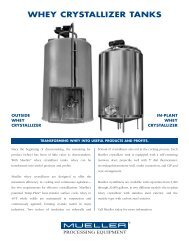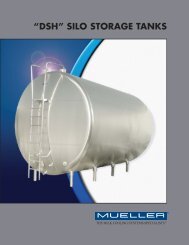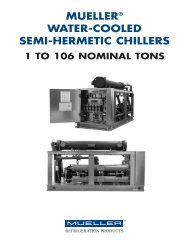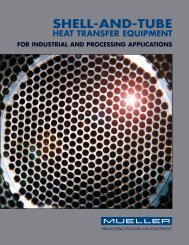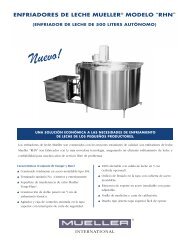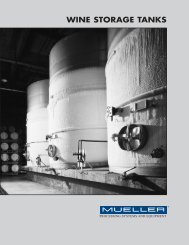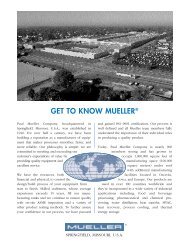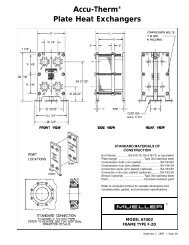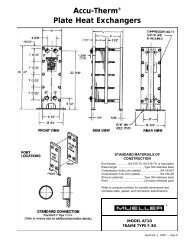ALL ABOUT TEMP-PLATE® - Paul Mueller Company
ALL ABOUT TEMP-PLATE® - Paul Mueller Company
ALL ABOUT TEMP-PLATE® - Paul Mueller Company
You also want an ePaper? Increase the reach of your titles
YUMPU automatically turns print PDFs into web optimized ePapers that Google loves.
18<br />
SOLVING HEAT TRANSFER PROBLEMS<br />
Example 2:<br />
Find the amount of Temp-Plate needed to cool 1,000<br />
gallons of syrup (50° Brix sucrose solution) from 150° to<br />
50°F in six hours. Temp-Plate will form the side walls of<br />
the cylindrical tank holding the syrup, and the tank will<br />
have 2" insulation. Water entering at 34°F will be<br />
circulated in the Temp-Plate. The sugar solution will be<br />
mechanically agitated. Tank dimensions are approximately<br />
70" OD x 93" long.<br />
Following the steps explained in the text:<br />
1. W = Weight of product = 10.25 lbs/gal (see table<br />
on page 19) = 1,000 x 10.25 = 10,250 lbs<br />
c = sp. ht. of product = .65 Btu/lb/°F (see table<br />
on page 19)<br />
t.d. = 150° – 50° = 100°F<br />
Product load, qp = 10,250 x .65 x 100 = 111,042<br />
6<br />
Exterior area = 195 sq ft<br />
Assume 80°F ambient, then average temperature<br />
difference = (150° + 50°) – 80° = 20°F<br />
2<br />
At 20° t.d., wall loss factor for 2" insulation = 4<br />
Btuh/sq ft (see table on page 22)<br />
Wall losses, qw = 4 x 195 = 780 Btuh<br />
Note: As average product temperature is greater than<br />
ambient, the 780 Btuh may be subtracted from the<br />
average cooling required.<br />
Total Load, qt = 111,042 – 780 = 110,262 Btuh<br />
2. From table on page 20 select overall heat transfer<br />
coefficient “U” of 60 Btuh/°F/sq ft (midway between<br />
maximum and minimum shown for agitated<br />
moderately viscous solution being cooled with water).<br />
3. The greatest temperature difference at start is<br />
150° – 34° = 116°. If the average temperature rise of<br />
the water being circulated is assumed to be around<br />
3°, we may use as the least temperature difference<br />
50° – 37° = 13°. Find ▲Tm of 44° on chart, page 21.<br />
4. A = qt = 110,262 = 41.8 sq ft<br />
U x (▲Tm) 60 x 44<br />
Example 3:<br />
Determine the amount of clamp-on Temp-Plate required<br />
to hold an uninsulated 20,000-gallon tank of fuel oil at<br />
40°F in ambient temperature that could go to -10°F<br />
minimum. Use 15 psig steam as the heating medium. The<br />
vessel is pad mounted, 12' diameter by 24' high. There is<br />
no agitation.<br />
Due to the relatively high thermal resistance at the interface<br />
of the Temp-Plate and tank wall, low “U” factors are<br />
expected. Assuming that a heat transfer mastic is used to<br />
obtain better contact, then select “U” of 30 Btuh/°F/sq ft.<br />
Surface area = 1,018 ft 2 (ignore heat transfer on<br />
bottom of pad-mounted vessel)<br />
t.d. = 40 – (-10) = 50°F<br />
Wall loss factor = 90 Btuh/sq ft (table on page 22)<br />
Then qw = 90 x 1,018 = 91,620 Btuh<br />
Steam temperature @ 15 psig = 250°F (table, page 23)<br />
Then A = 91,620 = 14.54 sq ft<br />
30 x (250 - 40)<br />
Better performance would result, particularly on an<br />
unagitated tank, if Temp-Plate is properly placed<br />
completely around the vessel. This would require<br />
approximately 38 sq ft if a one-foot-high band is utilized.<br />
See table on page 22 for the benefit of using insulation.



